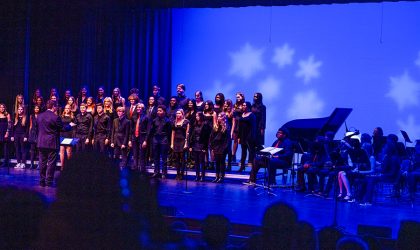

“I needed that.” Have you ever said those exact words after taking a break from your daily stresses? Maybe you planned a dinner with friends, played a round of golf, put the phone away and picked up a book, attended a church event, or had a quiet night in. Planned breaks from our busy lives help us to refill our cups, so to speak, so that we can pour into our families, jobs, and other responsibilities. But what about our kids?
 Has your student ever told you that they are stressed? Do you find it hard to believe that young people can truly be stressed? They are kids, after all – this is the easiest it will ever be, right? I thought so once, too. My mind changed when I became involved in Upper School Student Activities around our campus. Sponsoring the Student Council, planning Homecoming, Prom, clubs, exam week de-stressor activities, etc., allowed me to know your kids for more than the structured time I have with them in the classroom. Stepping outside of the information-giver and information-taker dynamic with students helped me get a better look into the lives of our young people. Over the last few years, I have learned that a day in the life of students can go something like this:
Has your student ever told you that they are stressed? Do you find it hard to believe that young people can truly be stressed? They are kids, after all – this is the easiest it will ever be, right? I thought so once, too. My mind changed when I became involved in Upper School Student Activities around our campus. Sponsoring the Student Council, planning Homecoming, Prom, clubs, exam week de-stressor activities, etc., allowed me to know your kids for more than the structured time I have with them in the classroom. Stepping outside of the information-giver and information-taker dynamic with students helped me get a better look into the lives of our young people. Over the last few years, I have learned that a day in the life of students can go something like this:
- A morning begins around 7:00 a.m. – at 8:15, school starts!
- The school day consists of rotating through at least five different academic subjects. In all of them, mastery needs to be accomplished by test time. During each block, students should focus their attention solely on the subject at hand.
- School ends at 3:00 p.m. – off to at least one type of practice or rehearsal, maybe two!
- Some students arrive home between 7:00 and 9:00 p.m. – or later if it’s a game night!
- Grab something to eat and get a good night of sleep! Just kidding, now it’s time for homework.
- Homework time averages anywhere from 45 minutes to 2 hours, so at times students are not hitting the sack until midnight.
Keep in mind, this schedule only revolves around their student-centered responsibilities. Our kids are not just students, though, are they? They are children, siblings, friends, artists, athletes, musicians, and various other things that require their time and attention. I do not know a single adult that could keep up this kind of schedule and remain stress-free. So what does this have to do with Student Activities? I firmly believe that student activities on our campus serve as a healthy outlet for students by accomplishing the following:
- Providing safe, age-appropriate activities and events for our kids – kids that live in a world that does not always feel safe and where age appropriateness is not a priority.
- Developing well-rounded young adults who can thrive in and outside the classroom.
- Providing opportunities for students to make a difference in the community.
- Creating a campus culture that feels safe, caring, and inclusive.
- Fostering more understanding (and caring) relationships between the adults and kids on our campus.
- Providing students with a mental reprieve from their daily, very real stresses.
- Allowing our kids to be kids.
- Filling up their cups!
When our students look back on their time at JA, I hope they will be proud of the education they received and, in addition, to have gone to a school that cared and provided for them as kids, not just students. Encourage your student to look for activities and opportunities on campus outside of the regular realm of the classroom – they just might say, “I needed that.”


